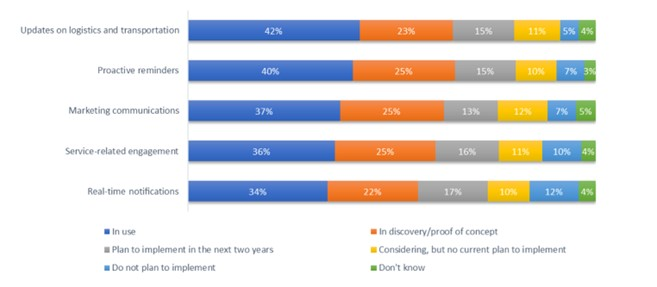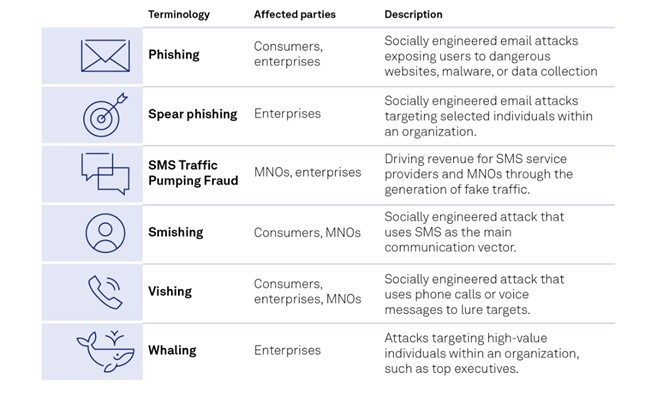S&P Global Offerings
Featured Topics
Featured Products
Events
S&P Global Offerings
Featured Topics
Featured Products
Events
S&P Global Offerings
Featured Topics
Featured Products
Events
Banking & Capital Markets
Economy & Finance
Energy Transition & Sustainability
Technology & Innovation
Podcasts & Newsletters
Banking & Capital Markets
Economy & Finance
Energy Transition & Sustainability
Technology & Innovation
Podcasts & Newsletters
S&P Global Offerings
Featured Topics
Featured Products
Events
Research — 9 May, 2023
Highlights
The misuse of mobile communications and digital channels can have numerous implications that go beyond annoying messages and phone calls that consumers have to put up with
SMS attacks include high-profile incidents such as FluBot, an SMS banking Trojan designed to steal private data from Android smartphones
Introduction
In December 2022, the U.S. Federal Communications Commission — which regulates interstate and international communications by radio, television, wire, satellite and cable in the U.S. — proposed a $300 million fine over an alleged auto warranty robocall scam. The scheme, involving more than five billion unsolicited calls to more than 550 million wireless and residential phones between January and March 2021, is the largest robocall operation the FCC has ever investigated. The incident illustrates the growing problem of abusive and fraudulent practices such as robocalls and spam SMS, which according to the FCC are the commission's top consumer complaint.
The misuse of mobile communications and digital channels can have numerous implications that go beyond annoying messages and phone calls that consumers have to put up with. In addition to negatively impacting a brand's reputation, they can result in account takeover and identity theft. Here, we look at threats that have emerged with the growing use of mobile communications — namely robocalls, spam SMS and artificially inflated traffic — and the implications these threats can have.
The Take
The use of mobile communications and digital channels for customer engagement has brought with it a growth in fraudulent activity leveraging these channels, with numerous implications for enterprise organizations, mobile network operators (MNOs) and the customer experience (CX). For consumers, this can range from annoying messages and phone calls to fraudulent transactions that seek to steal their money or identity. For organizations, this can result in consumers ignoring legitimate calls and messages containing alerts and other important notifications, leading to costly follow-up calls. For MNOs, this results in lost revenue due to reduced call completion rates; they also incur significant costs from investigating and resolving customer complaints. These factors highlight the relevance that trusted communications have as a critical requirement for enabling the digital customer experience, and the need for joint efforts across the entire ecosystem, including enterprise organizations, MNOs, communications PaaS providers and CX technology vendors.
The use of mobile A2P communications continues to grow
The use of mobile communications and digital channels enabling the digitization of the customer and employee experiences accelerated in the wake of COVID-19. According to 451 Research's Voice of the Enterprise: Workforce Productivity & Collaboration, Technology Ecosystems 2022 survey, organizations are increasingly relying on mobile application-to-person (A2P) communications for numerous use cases.
Our research shows that use of mobile A2P communications will likely continue to grow. For instance, 65% of survey respondents say their organization has deployed mobile A2P communications either in production (42%) or in proof of concept (23%) to provide logistics and transportation updates to their customers (Figure 1), with other use cases following a similar pattern.
Figure 1: Use Cases for Real-Time Mobile Communications for Customer Engagement

Source: 451 Research's Voice of the Enterprise: Workforce Productivity & Collaboration, Technology Ecosystems 2022.
Q. What is the state of current enterprise investment in each of the following tools used to communicate to your customers?
Base: All respondents (n = 480)
Key issues that enterprises should be aware of
Consumers are mostly familiar with spam, robocalls and phishing messages, which have significantly increased over the past two years. In general terms, spam refers to unsolicited messages sent over various channels. This includes bulk unsolicited campaigns, which are generic and not specifically targeted at an individual, with the aim of initiating communication — typically impacting subscribers more than enterprises. A second type includes campaigns targeting specific customers to collect sensitive information, incur costs or spread malware. Known as phishing, it can be considered a subset of spam, as well as a separate fraud category, and can impact subscribers and an organization's reputation.
Other emerging threats include smishing and artificially inflated traffic, which can have numerous implications for consumers, enterprise organizations, MNOs, and CPaaS and CX technology vendors (Figure 2).
Figure 2: Fraud Use Cases for Real-Time, Mobile Communications

Source: S&P Global Market Intelligence
Smishing
While robocalls and spam SMS can be considered an annoyance for mobile users, smishing — a portmanteau of SMS and phishing — can have significant financial implications for consumers and enterprises. The term refers to a social engineering attack that relies on fake text messages to trick people into downloading malware, sharing sensitive information or sending money to cybercriminals. Fraudsters will try to impersonate brands and copy their websites and processes, making it easy for mobile users to confuse the fraudulent communications with those sent by an authentic brand. Typical examples include delivery scams, where fraudsters mimic a logistics company's processes, tricking consumers into clicking through websites that seem valid to collect their personal information.
SMS attacks include high-profile incidents such as FluBot, an SMS banking Trojan designed to steal private data from Android smartphones. The malware masqueraded as an innocuous message — such as a missed call or delivery — asking the receiver to click on a link. First spotted in December 2020, it gained traction in 2021, compromising a significant number of devices worldwide. In May 2022, FluBot infrastructure was taken down in an operation involving 11 countries; it is not expected to resurge.
Artificially inflated traffic
Also known as SMS traffic pumping fraud, the term refers to the generation of fake traffic from legitimate websites and applications with the intent of driving revenue for SMS providers and MNOs. It happens when fraudsters take advantage of a phone number input field to receive a one-time passcode, an app download link or anything else via SMS.
Fraudsters will then use a bot to repeat the process, generating SMS messages to thousands of numbers. This is fake traffic that businesses are compelled to pay for, but is not converted into real business. Unfortunately, by the time an organization detects the fraud — typically by noticing an increase in signups from new countries, a sudden decrease in conversion rate, or a high number of signups from the same IP address or within a limited range of mobile numbers — it is already too late.
Implications for MNOs
Robocalls, spam SMS, smishing and artificially inflated traffic can have significant financial implications for MNOs. If MNOs are not securing the ecosystem or are involving providers that do not have high security standards (whether intentionally or unintentionally), they could be jeopardizing the security of their end users. The same holds true for enterprises, who might place their customers at risk and open the possibility for different frauds or privacy issues if they choose to use less expensive options for A2P and P2P communications in order to reduce costs.
Gray route providers typically do not have the infrastructure to handle sensitive content as they are not operating legitimately, so there is no incentive for them to invest in the security aspects of their platforms. With platforms that are not securely handling A2P traffic, there is a whole spectrum of opportunities for fraudsters to intercept A2P traffic or perform different fraudulent attacks on the end customers.
Research

